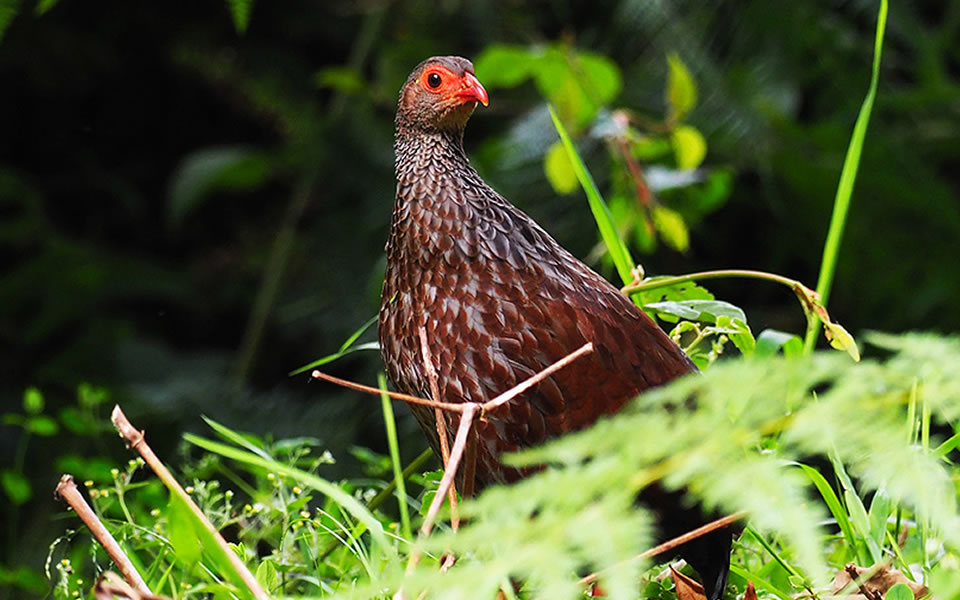Bird Watching in Volcanoes National Park (A Great Place to Watch Birds)
Approximately 200 bird species have been seen at Volcanoes National Park Rwanda, including 17 endemics to the Albertine Rift. However, Nyungwe National Park, which is better suited for birding, is where you’ll find the vast majority of the park’s unique avian residents. The endangered Grauer’s swamp warbler and the scarlet-tufted sunbird both call the top of Mt. Bisoke home.
The Ruwenzori double-collared sunbird, Baglafecht weaver, Black-crowned waxbill, and common stonechat ,Turaco de Ruwenzori

Bird Watching in Volcanoes National Park Rwanda
There is a wide variety of birds to see at Volcanoes National Park no matter the season, although the volcanoes tend to be cloudy and damp. Therefore, the best time to go bird watching in this region is during the Dry season, which runs from June to August, and the slightly less rainy months of September, January, and February. This is also prime season for seeing the mountain gorillas.
In addition to the golden monkeys and gorilla trekking activities that have made Volcanoes National Park renowned across the globe, bird watching is a popular pastime for visitors to the park. In addition to golden monkey trekking and gorilla trekking, birding is also possible here. The park is home to approximately 200 different bird species, the majority of which are indigenous to the Albertine Rift and are found only in the Virunga and Rwenzori Mountains.
You may see the Rwenzori turaco, the dusky crimson-wing, the Archer’s ground robin, the francolins, the Rwenzori double collared sunbird, the red-faced woodland warbler, the odd weaver, the collared apalis, and the Rwenzori batis, among many more species.
Species of Birds You Can Count on Spotting at Volcanoes National Park
Birdwatchers will never be bored on a safari through Volcanoes National Park. There are varied avifaunal species to keep an eye on all through while in the jungles and these include the Kivu ground thrush, Rwenzori batis, Grauer’s warblers, dusky crimson wing, Rwenzori double collared sunbird, Archer’s ground robin, strange weavers, red faced woodland warblers, collared apalis, Rwenzori Turaco, Lagden’s bush shrike, African green broadbill.
Tourists on a Rwanda safari may go bird watching at Volcanoes National area, and they may also see some of the other animals that the area is home to. The park also serves as a safe haven for a wide variety of other animals, such as bush bucks, mountain gorillas, golden monkeys , , duikers, buffalo, forest elephants,
What else can you do than go birding at Volcanoes National Park?
A birding safari in Volcanoes National Park is a must, but what should you bring? Whether you’re going to Volcanoes National Park or another great location for bird viewing, there’s a seemingly infinite list of necessities to bring along.

Bird Watching in Volcanoes National Park Rwanda
Wear a hat and sunglasses, long sleeves and pants because you’ll be walking through jungles with unpleasant vegetation that can injure your legs and arms, sturdy waterproof hiking boots, long socks, a walking stick, a rain jacket, and a sweater because of the erratic weather, and so on. Don’t leave home without a hired hand to assist you lug your suitcase.
You may see approximately 180 different kinds of birds in Volcanoes National Park, including the African green broadbill, the Kivu ground thrush, and the Lagden’s Bush-shrike, among many more besides gorillas. Binoculars, a high-quality camera with spare batteries and memory cards, a field guide, a valid passport, a visa, a yellow fever certificate (obtained well in advance of the actual date of travel), sun protection products, insect repellents, long pants, a flashlight, a waterproof field bag, waterproof hiking boots, a rain jacket, anti-malaria pills, toiletries, a safari hat, long-sleeved shirts, and sunglasses.
It doesn’t matter what time of year it is, Volcanoes National Park is a great place to go bird watching. This is because the local climate and weather are ideal. The dry months of June, July, and August, as well as December and January, make it easier to travel the rain-forest of this park and identify most of its species. The rainy season is also the breeding season for most birds, so November and April are great times to go bird watching in this area because of all the migrating species.
Mountain gorillas, golden monkeys, African elephants, Forest Buffaloes, the black-fronted duikers, and bush bucks are just some of the animal species that call Volcanoes National Park home. Mount Karisimbi, Mount Bisoke, Mount Sabinyo, Mount Gahinga, and Mount Muhabura are only five of the eight volcanoes that make up the Virunga Massif, all of which are located inside the forest park. So, you can also experience cultural encounters, gorilla trekking, golden monkey tracking, and more. You can also go to Dian Fossey’s burial site, see the Twin Lakes of Ruhondo and Bulera, and more.
Volcanoes National Park is a great option for birdwatchers planning a trip to Rwanda. If you have any questions about bird watching in Rwanda’s Volcanoes National Park, please don’t hesitate to contact ACTIVE AFRICAN VACATION.
